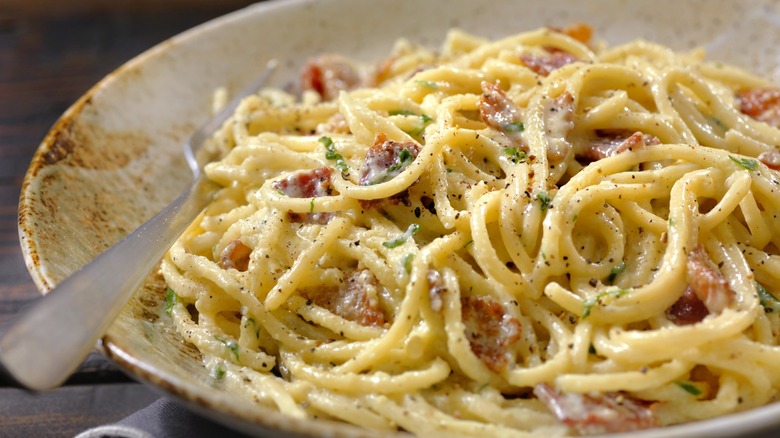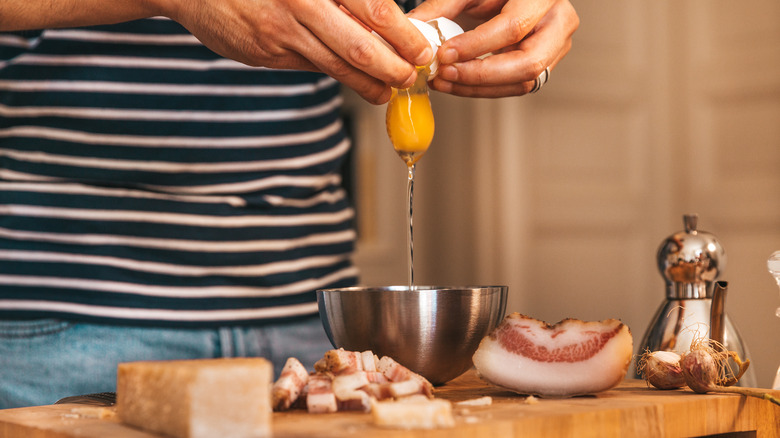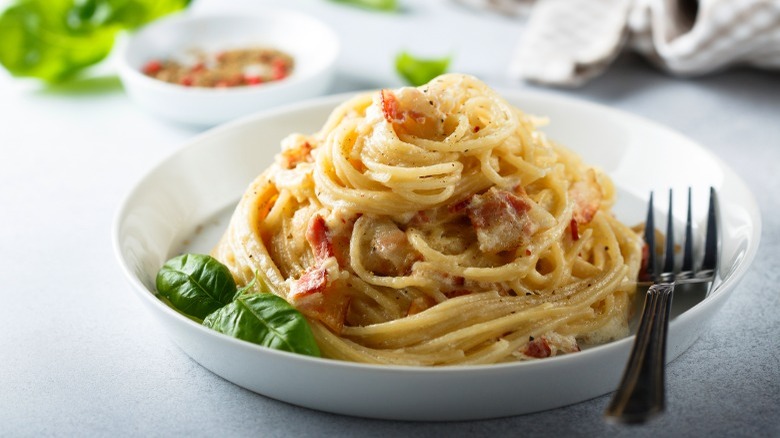Why It's Essential To Use Room Temperature Eggs In Carbonara
When you're craving a savory, filling pasta dish, spaghetti carbonara may be exactly what you need. This Italian classic is made with only a few ingredients, mainly pasta, eggs, Parmesan or Pecorino Romano cheese, black pepper, and cured pork. However, the sauce itself requires a bit of careful technique. The raw eggs are blended and cooked with the other ingredients to create that signature creamy texture, but using eggs that are fridge-cold can cause the sauce to turn clumpy. You'll want to make sure they're at room temperature before you add them to the pan.
To make carbonara, the eggs are whisked thoroughly with the other sauce ingredients before tossing it with the pasta. If you mix cold eggs directly into the hot sauce, they can seize and form lumps. Room temperature egg yolks and whites, on the other hand, will mix into the sauce smoothly. If you avoid shocking the rest of the sauce with cold eggs, you should end up with delectably smooth and creamy results.
By definition, room temperature refers to a range between 68 to 72 degrees Fahrenheit. When left out on the kitchen countertop, eggs will reach this temperature after around 20 to 30 minutes — though it's important to pay attention to the temperature of your kitchen. A warm room could heat the eggs up faster, or slower, if your house is chilly. Just be sure not to leave the eggs out for longer than two hours, or they may begin growing foodborne bacteria.
Other temperature tips for carbonara
With all of this being said, sometimes cold eggs can be beneficial for carbonara — but only prior to the cooking process. Egg yolks and whites can be separated a little easier when they're chilled, making a finicky task a bit simpler. Carbonara recipes sometimes call for more egg yolks than whites, so you can separate your egg yolks out at the beginning of your prep, then leave them in a bowl to warm up to room temperature. After they've warmed up, you can add them into your sauce mixture.
Additionally, you not only have to pay attention to the temperature of your eggs, but also the pan you cook them in. Using too much heat is a common carbonara mistake that can scramble your eggs. While scrambled eggs might taste delicious on the breakfast table, they aren't what you want in your pasta carbonara.
This outcome can be avoided by cooking your sauce together over gentle heat. Then, after you've cooked and drained your pasta, add it back to a pot that is removed from the heat source on your stovetop. Once the noodles cool down a bit, you can add in your eggy sauce and toss to coat. The pasta should hold onto just enough heat to cook the eggs and create a smooth, rich coating.
What to do if you forget to take out the eggs
If you forget to bring your eggs to room temperature, you may be able to slowly heat up your sauce without scrambling the eggs. To temper the eggs in a pinch, you'll need to reserve a little bit of the water that your pasta was cooked in. You can use leftover pasta water to thicken sauces and keep them smooth and emulsified, thanks to the starch released by the noodles.
While whisking the cold eggs into your sauce, slowly pour in the hot pasta water, mixing constantly until it's thoroughly combined. The slow incorporation process, combined with the consistent whisking, should raise the temperature of the ingredients gradually, and the eggs won't end up scrambling or forming clumps. Once it's all mixed with the warm pasta, the heat from the noodles will continue to cook the egg in the sauce and form a velvety texture. While this method will work in a pinch, setting your eggs out to rest at room temperature can help you skip the extra work and end up with perfect results.


